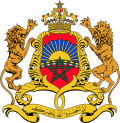
Back سلالة العلويين الفيلاليين الحاكمة Arabic سلالة لعلويين لفيلاليين لحاكمة ARY Dinastía alauí AST Ələvilər sülaləsi Azerbaijani Dinastia alauita Catalan Alaouite Czech Alawiden German Dinastía alauí Spanish Alauiak Basque علویان (مراکش) Persian
| 'Alawi dynasty سلالة العلويين الفيلاليين | |
|---|---|
| Parent house | Banu Hassan, of Banu Hashim, of Quraysh |
| Country | |
| Founded | 1631 |
| Founder | Sharif bin Ali (died 1659) |
| Current head | Mohammed VI |
| Titles | Sultan of Tafilalt (1631–1666) Sultan of Morocco (1666–1957) King of Morocco (1957–present) |
| Style(s) | Amir al-Mu'minin |
| Estate(s) | Morocco |
| History of Morocco |
|---|
 |
| Historical Arab states and dynasties |
|---|
 |
| Royal family of Morocco |
|---|
 |
|
The 'Alawi dynasty (Arabic: سلالة العلويين الفيلاليين, romanized: sulālat al-ʿalawiyyīn al-fīlāliyyīn) – also rendered in English as Alaouite, 'Alawid,[1][2] or Alawite[3] – is the current Moroccan royal family and reigning dynasty. They are an Arab sharifian dynasty and claim descent from the Islamic prophet Muhammad through his grandson, Hasan ibn Ali.[4] Their ancestors originally migrated to the Tafilalt region, in present-day Morocco, from Yanbu on the coast of the Hejaz in the 12th or 13th century.[5][6][7]
The dynasty rose to power in the 17th century, beginning with Mawlay al-Sharif who was declared sultan of the Tafilalt in 1631. His son Al-Rashid, ruling from 1664 to 1672, was able to unite and pacify the country after a long period of regional divisions caused by the weakening of the Saadi Dynasty. His brother Isma'il presided over a period of strong central rule between 1672 and 1727, one of the longest reigns of any Moroccan sultan. After Isma'il's death the country was plunged into disarray as his sons fought over his succession, but order was re-established under the long reign of Muhammad ibn Abdallah in the second half of the 18th century. The 19th century was marked by the growing influence of European powers.
The 'Alawis ruled as sovereign sultans up until 1912, when the French protectorate and Spanish protectorate were imposed on Morocco. They were retained as symbolic sultans under colonial rule. When the country regained its independence in 1956, Mohammed V, who had supported the nationalist cause, resumed the 'Alawi role as independent head of state. Shortly afterwards, in 1957, he adopted the title of "King" instead of "Sultan".[8] His successors, Hassan II and Mohammed VI (the current reigning monarch), have continued the dynasty's rule under the same title. Today, the Moroccan government is officially a constitutional monarchy,[9][10][11] but the king retains strong authoritarian power over the state and public affairs, despite some political reforms in recent decades.[12][11][13][14][15]
- ^ Cite error: The named reference
:2was invoked but never defined (see the help page). - ^ Cite error: The named reference
:0was invoked but never defined (see the help page). - ^ Cite error: The named reference
:15was invoked but never defined (see the help page). - ^ "العلويون/الفيلاليون في المغرب". www.hukam.net. Retrieved 2022-04-06.
- ^ Messier, Ronald A.; Miller, James A. (2015). The Last Civilized Place: Sijilmasa and Its Saharan Destiny. University of Texas Press. ISBN 978-0-292-76667-9.
- ^ Morrow, John Andrew (2020). Shi'ism in the Maghrib and al-Andalus, Volume One: History. Cambridge Scholars Publishing. p. 66. ISBN 978-1-5275-6284-4.
- ^ "ينـبع النـخـل .. لا نـبع ولا نـخل - أخبار السعودية | صحيفة عكاظ". 2019-11-04. Archived from the original on 2019-11-04. Retrieved 2022-04-06.
- ^ Jones, Barry (2017). Dictionary of World Biography: Fourth edition. ANU Press. p. 591. ISBN 978-1-76046-126-3.
- ^ "Morocco | History, Map, Flag, Capital, People, & Facts | Britannica". www.britannica.com. Retrieved 2022-09-20.
- ^ "Morocco; Government". The World Factbook. Central Intelligence Agency. 12 September 2022. Retrieved September 21, 2022.
- ^ a b Daadaoui, M. (2011). Moroccan Monarchy and the Islamist Challenge: Maintaining Makhzen Power. Springer. p. 61. ISBN 978-0-230-12006-8.
The dominance of the monarchy in the sociopolitical arena is further institutionalized in the Moroccan constitution, which effectively diffuses makhzenite authority into three separate branches: executive, legislative, and judicial. While this separation of powers is informed by western style government, it does effectively place all powers under the iron grip of the monarch. Article 1 of the constitution promulgating a constitutional monarchy in Morocco is misleading, insofar as the king is not a figurehead acting as a symbol of unity for Moroccans. In fact the constitution, amended five times since the independence, has largely served to the traditional prerogatives of the monarchy.
- ^ Gilson Miller, Susan (2013). A History of Modern Morocco. Cambridge University Press. pp. 235–236. ISBN 9781139619110.
The most important innovations, however, were the limitations on the king's ability to intervene in day-to-day politics. While the king's role as "supreme arbiter" of political life remained unquestioned, the new [2011] constitution enhanced the legislative powers of the parliament and increased the independence of the judiciary, moving at least in spirit toward a separation of powers. What it did not do was to unequivocally limit the king's preponderant influence over public affairs, or move Morocco closer to becoming a parliamentary monarchy; in other words, it stopped short of remaking Muhammad VI into "a king who reigns but does not rule."
- ^ Sater, James N. (2016). Morocco: Challenges to tradition and modernity. Routledge. p. 104. ISBN 978-1-317-57398-2.
Recent reforms, including constitutional reform and the appointment of the PJD government in 2011, have only perpetuated the lack of meaningful political participation and supported authoritarianism. Ironically, reforms have multiplied the resources available to Morocco's monarchical institution to control the political sphere, creating the image of the Janus yet also an impasse.
- ^ "Analysis | Why Jordan and Morocco are doubling down on royal rule". Washington Post. 16 May 2017. ISSN 0190-8286. Retrieved 2022-09-20.
- ^ "Morocco: Freedom in the World 2022 Country Report". Freedom House. 2022. Retrieved 2022-09-21.
© MMXXIII Rich X Search. We shall prevail. All rights reserved. Rich X Search